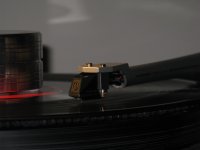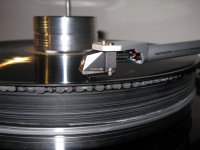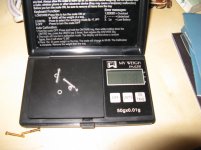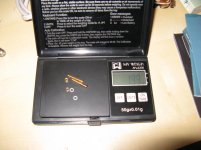ok ok, thanks Salas!
i will try in the next days.
Alright. Good luck and let us know your progress.
Temp...
I used a brass mesh as lid since temp. got a bit high in the cramped compartment where it resides. The mesh took it from +15 to +7 C above ambient.
I used a brass mesh as lid since temp. got a bit high in the cramped compartment where it resides. The mesh took it from +15 to +7 C above ambient.
An externally hosted image should be here but it was not working when we last tested it.
Last edited:
After my Shelter had a suspension damage, had to do something, as my Denon 103 I had for backup was nice but something was missing.
So here it is an Audio Technica AT-ART9.
I think that I took a little bit of risk as not so may around to get a meaningful feedback, but went for it.
Only a few hours so far, but really satisfied. In fact is the best cart I heard so far, including a few Lyras from the past. It surely needs some hours first before making final conclusions, but so far I think it' s among the top ones. Most probably you need much more money to even or better it.
So here it is an Audio Technica AT-ART9.
I think that I took a little bit of risk as not so may around to get a meaningful feedback, but went for it.
Only a few hours so far, but really satisfied. In fact is the best cart I heard so far, including a few Lyras from the past. It surely needs some hours first before making final conclusions, but so far I think it' s among the top ones. Most probably you need much more money to even or better it.
Attachments
Those are excellent quality brass screws that were in my AT's jewel box too. They are bit heavy but Audio-Technica claims they play a role for a controlled mounting regarding vibrations travel. Me I could not use them because my shell is blind on top and they are longer than fitting it correctly. Try Alu because ART9 is more compliant than 33 PTG/II and the SME is medium mass. Shaving off a bit of moving mass anywhere possible is even better.
I will test the resonance frequency of the 33+774 (11gr modded) again now that it seems like breaking in. It was 9Hz initially. Those carts are very demanding on setting them right. The sound has already taken on a massive bubble around and behind the speakers with deep bass and thick power range. Very 3D. Smooth also so I may re-evaluate the max allowable loading value for gaining max resolution before thinning out. But its a matter of tonal synergy with the line preamp too.
Hi.
How do you "test" it?
Regards
Assuming you mean the resonant frequency, either with a test disk of by doing an FFT on a blank disk portion and watch at which frequency is the resonant peak.
FFT on highest points for enough digital bins resolution down low on ARTA and the like. Fs will show on any record. Alone and cleaner to see on a non modulated vinyl portion. There is the HFNRR test disc II indicative side two lateral track 2 also announcing Hz, but its very about. Some measured it and wrote that it should be interpreted as: Audio Asylum Thread Printer
That was on the first HFNRR disc but version II (current) appears the same from other experiments on the web:
25 Hz = 24.4 Hz
23 Hz = 21.6 Hz
21 Hz = 19.6 Hz
19 Hz = 17.2 Hz
17 Hz = 15.7 Hz
15 Hz = 14.5 Hz
13 Hz = 11.1 Hz
11 Hz = 10.8 Hz
9 Hz = 8.7 Hz
7 Hz = 5.7 Hz
That was on the first HFNRR disc but version II (current) appears the same from other experiments on the web:
25 Hz = 24.4 Hz
23 Hz = 21.6 Hz
21 Hz = 19.6 Hz
19 Hz = 17.2 Hz
17 Hz = 15.7 Hz
15 Hz = 14.5 Hz
13 Hz = 11.1 Hz
11 Hz = 10.8 Hz
9 Hz = 8.7 Hz
7 Hz = 5.7 Hz
Project finish delayed - so I lost all connection to reality
Thought I had all needed to finish the phono amp two weekends ago.
I realized I did not have the needed interstage and output cap (and the nylon screws to mount the power transformers) so I lost all inhibition and ordered a 0.1 copper VCAP and a 2.2 uF DUELUND
The power transformers will be isolated from the box.
Partsconnexion has the DUELUND's at a better price and I thought these things will be useful for the rest of my life, so why not?
Simple circuits reveal shortcomings in components so why not throw the best you can at it? (you can hear the attempt to justify extravagance).
Nice that PAYPAL allows one to break up the payment over six months.
So this is why I have not posted my report of a finished project. Still waiting for those nylon screws to mount the power transformers ...
A question concerning enclosing the circuit - I thought it was highly recommended that the circuit be in a box to keep temperature constant and then I see the brass mesh. I like the idea of tube circuits being exposed/not in a box and thought I would do the same with this until cautioned otherwise.
How important is this?
AND if the above is important I saw something I thought interesting. In an audio show report someone mentioned a company that is filling their boxes with wool. I like filling speaker boxes with wool but had never thought of putting it into an electronics enclosure. Wool is very difficult to ignite and even harder to keep ignited. Seems if a constant temperature was a virtue with this circuit this could be a good way to add a measure of consistency to the temperature and couldn't hurt stifling resonances within the box.
What is the best practice for housing this circuit?
Thought I had all needed to finish the phono amp two weekends ago.
I realized I did not have the needed interstage and output cap (and the nylon screws to mount the power transformers) so I lost all inhibition and ordered a 0.1 copper VCAP and a 2.2 uF DUELUND
The power transformers will be isolated from the box.
Partsconnexion has the DUELUND's at a better price and I thought these things will be useful for the rest of my life, so why not?
Simple circuits reveal shortcomings in components so why not throw the best you can at it? (you can hear the attempt to justify extravagance).
Nice that PAYPAL allows one to break up the payment over six months.
So this is why I have not posted my report of a finished project. Still waiting for those nylon screws to mount the power transformers ...
A question concerning enclosing the circuit - I thought it was highly recommended that the circuit be in a box to keep temperature constant and then I see the brass mesh. I like the idea of tube circuits being exposed/not in a box and thought I would do the same with this until cautioned otherwise.
How important is this?
AND if the above is important I saw something I thought interesting. In an audio show report someone mentioned a company that is filling their boxes with wool. I like filling speaker boxes with wool but had never thought of putting it into an electronics enclosure. Wool is very difficult to ignite and even harder to keep ignited. Seems if a constant temperature was a virtue with this circuit this could be a good way to add a measure of consistency to the temperature and couldn't hurt stifling resonances within the box.
What is the best practice for housing this circuit?
Biggish box IMHO is better than "much airy" smaller box because it contains the moderate temperature lift that the sinks radiation will create, when completely open will expose the innards to aircon draught etc. creating a wider temp delta in some occasions. I.e. by following the room conditions more faithfully. The important thing is to have consistent enough TP1-TP2 reading after 30 minutes warm up through the year with the lid closed. Not spot on, but staying there about. There are small parts developing temperature in there like R13 and the JFETs so wool could interfere with them freely dissipating. Not to mention the MOSFETs sinks. What kind of TT and cart you got? They should be very good when investing in top dollar passive parts. We will be happy to know your results and see your build efforts soon.
- Home
- Source & Line
- Analogue Source
- Simplistic NJFET RIAA



